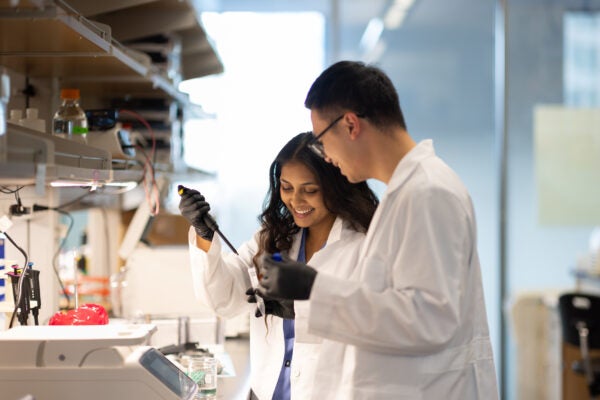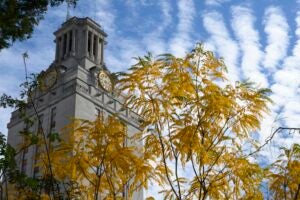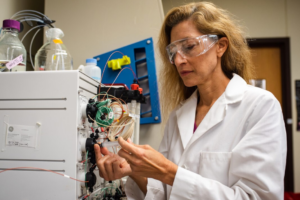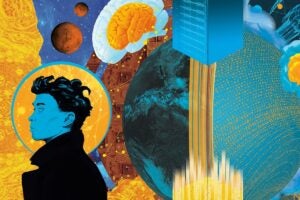Two Dell Medical School students are celebrating publication in a peer-reviewed journal — a major milestone reached far earlier than most in their medical training.
Cheyenne Ahamed and Lam Nguyen, now second-year students, co-authored a manuscript in Neuro-Oncology Advances titled “Targeting the Tumor Microenvironment in Pediatric Gliomas: Advances and Future Directions in Immunotherapy.” The paper, developed during their first year at Dell Med, reflects a core element of the school’s mission: engaging students early in translational research with real-world impact.
“Seeing students publish in a major journal this early is a significant achievement and a testament to their abilities, dedication and curiosity,” says James Korndorffer, M.D., vice dean of education at Dell Med. “It reflects Dell Med’s distinctive approach — a culture of innovation, collaboration and inquiry where students are encouraged from day one to pursue research, ask questions and make meaningful contributions to medicine.”
The project took shape in the lab of Kevin Kumar, M.D., Ph.D., a neurosurgeon-scientist in Dell Med’s Department of Neurosurgery. His research approach intentionally includes students in hands-on discovery from the outset.
“I view students as future colleagues,” Kumar says. “Cheyenne and Lam’s initiative reflects the type of collaborative, curiosity-driven research environment we want to cultivate at Dell Med.”
Addressing a Critical Gap in Care
Glioma, a type of brain tumor, remains one of the most difficult pediatric cancers to treat. Treatments for children are often adapted from adult protocols, with limited effectiveness. Ahamed noted a lack of research differentiating the tumor microenvironment in adult versus pediatric cases.
“There wasn’t a lot of literature distinguishing adult and pediatric tumor environments,” she says. “Most treatments are designed for adults, but they don’t always translate well to kids. That gap pushed me to ask more questions.”
Nguyen adds: “People focus on the tumor itself. But it’s surrounded by a complex environment that, in pediatrics, is especially immunosuppressive. That makes it harder for therapies to reach the tumor.”
Beyond the Bench

Ahamed and Nguyen were among the first students to join Kumar’s lab, stepping into a newly forming research environment and helping shape its direction from the ground up. Both brought perspectives shaped by their previous academic paths and found opportunities to translate those experiences into meaningful contributions.
Ahamed, who studied biomedical engineering at The University of Texas at Austin, focused on computational modeling of the tumor microenvironment. Her training gave her a dual lens: the ability to analyze complex biological systems and the instinct to center the patient within them.
“Engineering taught me to not just treat a problem, but to treat the person experiencing it,” she says. “That perspective is key in pediatric research.”
Nguyen says he saw the experience as a bridge between his coursework and an emerging interest in neurosurgery. The project deepened his understanding of the complexity of tumor biology, particularly in children — a population often underrepresented in research funding and innovation.
Their early involvement gave them a rare level of ownership. They contributed not only to the scientific findings, but also to the development and direction of the research itself.
A Milestone for Dell Med
Ahamed and Nguyen’s work represents more than a personal achievement — it’s an example of how students at Dell Med are contributing to the advancement of complex, high-need areas like pediatric neuroscience. As part of Kumar’s lab, they helped lay the foundation for a growing program focused on translational discovery with direct patient impact, and in doing so, they experienced academic medicine in action.
For both students, the lab was more than a research setting. It was a space to try, to iterate and to learn in the way Dell Med students often do: by diving in.
“We were given the space to fail freely and learn from mistakes,” Nyugen reflects. “That collaborative, supportive atmosphere made this possible.”
As Dell Med leads the academic and educational mission of a new integrated medical center in Austin — historically the largest U.S. city without an academic health system — students like Ahamed and Nguyen exemplify what’s possible when learners are empowered to drive subspecialty care forward.
“This manuscript lays the groundwork for future studies in our lab and beyond,” Kumar says. “The questions Cheyenne and Lam are exploring will help shape how we think about immunotherapy in pediatric neuro-oncology — and that could ultimately change patient care.”




